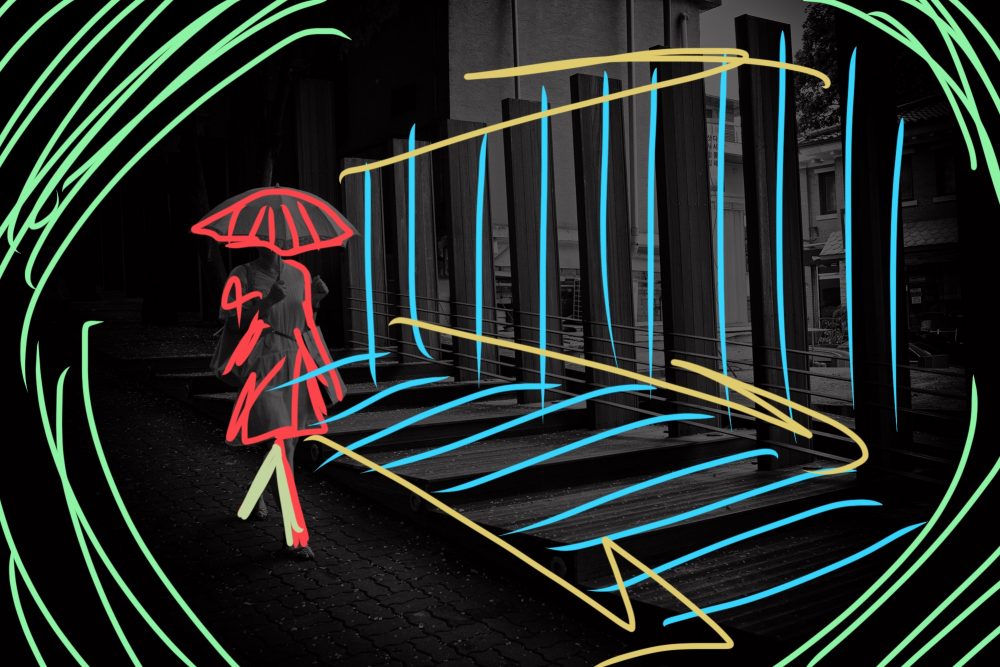To make better pictures, add more motion:
Why does motion make better photos?

Motion is more dynamic, with more energy and power!

Real life is in motion. Thus, my theory is this:
Photographing objects that evoke a spirit of movement engages you more as a viewer!
1. Body movement

2. Blur

3. Distance
Someone actively walking away from you:

Tension between two subjects:

4. Taking photos while your subject is moving around

In this picture, I was photographing Cindy at a bridge in Hue, Vietnam. I first framed her head in-between the leading lines in the background, then asked Cindy to shake her head around:

Note the leading lines in magenta, and Cindy’s face in cyan:






5. Active motion (subject turning around to face you):










6. Photographing your subject head-on, while they walk towards you
Shot on Leica M9, 35mm, with flash (while subject is walking towards me), at 1/12th shutter speed (slow).

With arrows drawn in Photoshop:

7. Leading lines in the background

Find a background with interesting leading lines, and use the ‘fishing technique‘ — wait for your subject to enter the frame:

8. Curve





Composition 101 >

Master composition for yourself:
Photography Composition Tips

- Photography Composition: Which Direction is Your Subject Looking?
- Blocking Technique in Photography
- How to Shoot a Triangle Photography Composition
- How to shoot a golden triangle composition in street photography
- 8 Simple Curve Composition Tips
- 5 Simple Henri Cartier-Bresson Composition Tips
- Foot Zoom
- Photography Composition: Light and Dark
- Street Photography Composition Lesson #16: Scale
- Shape, Arrangement, Position (S.A.P.) and Contour, Inter-Contact, Position (C.I.A.) in Photography
- 10 Tips How to Fill the Frame in Photography
- Look Up! 16 Photography Composition Perspective Tips
- 5 Simple Street Photography Composition Tips
- Depth Perception
- Golden Angle Composition in Street Photography
- Photographer as an “Arranging Artist”
- Dynamic Off-Center Street Photography Compositions
- 5 Essential Composition Tips in Photography
Color Theory

- Red and Green Composition Color Theory For Photographers
- The Ultimate Beginner’s Guide to Color Photography
- Opponent Process Color Theory For Photographers
- Color Theory For Photographers
- Color Manual
- How to Shoot Color Street Photography
Learn From the Masters of Composition

- 10 Lessons Matisse Can Teach You About Art and Life
- Henri Cartier-Bresson Composition
- 10 Timeless Lessons Edward Weston Can Teach You About Photography
- 10 Inspirational Sergio Larrain Compositions
- 5 Henri Cartier-Bresson Photography Composition Lessons
Dynamic Photography Composition 101

- Introduction to Dynamic Photography Composition
- How to Visually Analyze Your Photography Compositions
- Dynamic Tension: Opponent Based Theory For Photography
- Opponent Process Color Theory For Photographers
- Dynamic Photography Composition 101: Figure to Ground
Painting Compositions

Dynamic Photography Composition Tips

- 7 Simple Photography Composition Tips
- How to Make Aggressive Photography Compositions
- 10 Dynamic Photography Composition Tips
- How to Make More Dynamic Picture Compositions
- Unorthodox Photography Composition Techniques
- Deconstructed: Saigon Eric Kim Photos
Composition Theory

Take your composition to the next level:
- Gestalt Theory
- Juxtaposition
- Center Eye
- Low-Angle
- Dutch Angle
- Deep Depth
- Spacing
- Silhouette
- Leading Lines
- Figure to Ground
- Fibonacci Spiral
- Cropping
- Emotion
- Composition by Eric Kim
Street Photography Composition 101

For distilled lessons on composition, read the free ebook: “The Street Photography Composition Manual.”
Further articles to improve your compositions in photography:
- Composition Lesson #1: Triangles
- Composition Lesson #2: Figure-to-ground
- Composition Lesson #3: Diagonals
- Composition Lesson #4: Leading Lines
- Composition Lesson #5: Depth
- Composition Lesson #6: Framing
- Composition Lesson #7: Perspective
- Composition Lesson #8: Curves
- Composition Lesson #9: Self-Portraits
- Composition Lesson #10: Urban Landscapes
- Composition Lesson #11: “Spot the not”
- Composition Lesson #12: Color Theory
- Composition Lesson #13: Multiple-Subjects
- Composition Lesson #14: Square Format
Composition Theory

Learn compositional theory:
- Why is Composition Important?
- Don’t Think About Composition When You’re Shooting Street Photography
- How to Use Negative Space
- Street Photography Composition 101
- The Theory of Composition in Street Photography: 7 Lessons from Henri Cartier-Bresson
Compositional lessons from the masters of art
Composition lectures
Composition pictures/grids


Golden Diagonal Composition













